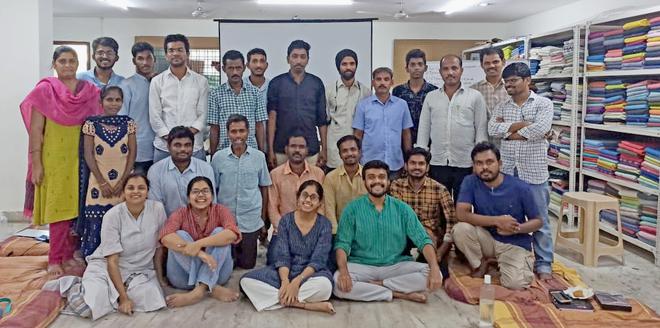Chitrika is developing contemporary designs using Kuppadam, Jamdani and Ballakammi techniques
Chitrika is developing contemporary designs using Kuppadam, Jamdani and Ballakammi techniques
The Hyderabad office of Chitrika, an artisan manufacturing company that works with 300 handloom weaver families in Panduru and East Godavari districts of Srikakulam district, Mandapeta in Andhra Pradesh and Narayanpet district of Telangana, is equipped with rack stocking saris and garments. On some clothing stands are samples of Chitrika’s recent experiments – garments in contemporary silhouettes that target young shoppers.
Vijaya Swita Grandhi, who founded Chitrika in 2005, says experimentation along with traditional weaving has been a continuous process. The design terminology evolved gradually: “We encouraged and offered incentives to weavers to develop at least three new designs a year. We do not tinker with traditional techniques (Jamdani, Kuppadam and Ballakammi) but look for new designs.
design intervention
Chitrika attracted online buyers through chitrika.in during the pandemic. After tasting success at the exhibitions organized by the Crafts Council of Telangana, the label launched the ready-to-wear collection for its online customers.
The collection includes crop tops, high-low anti-fit tunics, straight fit trousers, dhoti pants, flared pants, and more: “There are buyers for traditional kurtas, but we break the monotony of salwar-kurtas with new cuts want,” says Switha.
Chitrika Handloom Weavers, Hyderabad | photo credit: special arrangement
The garment line is more than just sewing existing handloom fabrics into new silhouettes, but also rethinking design at the loom level. If a design panel is to run along the outer edge of the trouser, the pattern derives from the weave itself, rather than the stitched patch onto the trouser fabric. Similarly, the concept of checkered pattern on blouse is done at the knitting stage. The design intervention got a boost when fashion graduates Mahima Khare and Amogha GS joined the label in 2020.
origin story
Swita learned the essentials of working with the rural sector during her Post Graduate Diploma in Risk Management course at the Institute of Rural Management, Anand (IRMA), Gujarat: “We were taught to work with the rural community and help businesses grow. Due to my roots in Kancheepuram and interest in weaving and crafts, I decided to work in the handloom sector. ,
The learning curve was full of ups and downs until 2011. It was not easy to break into the craft network, where established players, both government aided units and private operators had already made contact with spinners and weavers. Chitrika started working with 10 weavers near Panduru in 2006 and expanded its footprint to East Godavari in 2013 and Narayanpet in 2017 to reach 300 families. “We also have a network of ex-loom workers; And the dyeing is outsourced.”
weaving and techniques
Chitrika weavers are experts in Jamdani, Srigadi Chek, Butas, Kuppadam and Ballakammi.
In Srikakulam, Ballakammi weaving is an additional weft technique used to create textured patterns, mostly on the pallu.
Srikakulam Kuppadam is an interlocking technique used to create temple borders in contrasting colours. A loom is operated by two weavers.
The Kuppadam of East Godavari is an interlocking technique used to create contrast borders, but not in temple designs. A loom can be operated by one weaver.
The label employs natural dyes in pastel colors for khadi and azo free reactive and vat dyes for other cotton fabrics.
no-bleed color
The label claims to offer zero bleed handloom. Swita attributes this to the quality of the colors as well as the mechanized process: “People think mechanizing anything in a handloom is blasphemy. Some repetitive and non-creative processes can be mechanised.” The ‘Aasu’ machine used for yarn winding by Pochampally weavers is an example.
Elaborating on the blood of dyes in handlooms, Swita says: “Dyeing is a laborious process and there is a possibility that overworked or inadequately trained workers may wash the dyed cloth less often than necessary. Huh; So the extra color flows through.”
Looking back, they are happy that Chitrika has done a cumulative business of ₹18 crores since inception, and got rid of the pandemic. “We want to start a dyeing unit and this requires an investment of ₹3 crore; Raising funds remains a challenge. ,
Chitrika sells directly to customers and supplies clothing and finished products to established handloom retail labels. Swita takes the discourse about handloom revival with a pinch of salt: “There are fewer weavers today than there were a decade ago, while demand remains the same.”

Chitrika Team | photo credit: special arrangement
road ahead
By 2030, the organization hopes to enable an ecosystem that will benefit 10,000 artisan families. Design experiments will continue. Showcasing a design panel where the traditional Ballakami has been transformed to result in new patterns, she explains how the minimalistic designs on sarees without elaborate borders can make for a perfect workwear.
For fabrics, the team is also estimating fabric and tensile strength fall in addition to laundry and shrink experiments: “We aim to offer fabrics in three categories – under ₹1000, ₹2000 and ₹3000.”
Chitrika will have its own store in the Crafts Council of Telangana Building CCT space in Banjara Hills later this year.